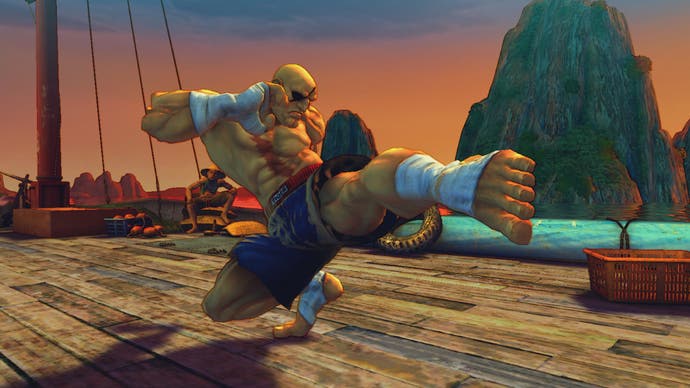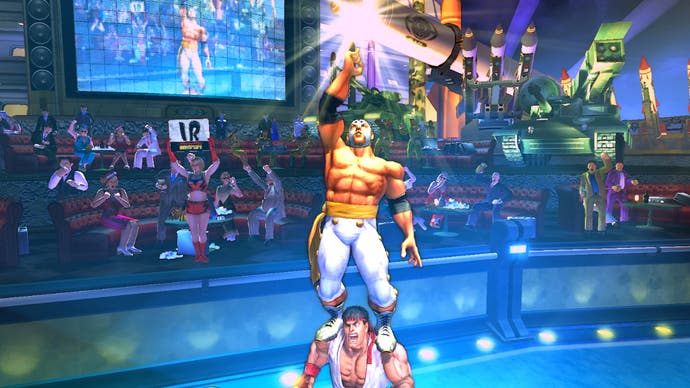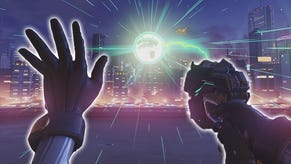Street Fighter IV
Kick, punch, it's all in the mind.
"So, what do you think of it then?"
I'm standing behind the Street Fighter IV cabinet at ATEI, the UK's only amusement arcade exhibition. Around the machine loiters a group of twentysomethings, all of whom invented or lied about the names of companies they work for in order to gain access to this supposedly industry-only exhibition. They lied because of this game and this game alone.
We're playing winner-stays-on. The kid on the right, Akuma, is on a seventeen-win streak. He's wearing a single, fingerless leather glove on his right hand, presumably to absorb the sweat that comes from being a champion. It is super-dramatic.
The young man I'm standing with turns to answer my question. He looks me in the eye and says: "Dude. This game is the second coming. The actual second coming."
Two minutes later, glove-boy loses to a New Challenger. The place erupts with cheers, fast dampened as we remember we're supposed to be here to assess whether or not to lay down the GBP 12,000 asking price for two of these machines, not to partake in an impromptu tournament.
Five months earlier, I'm sat in a Tokyo restaurant talking with staff members from Square Enix. One man is lamenting the fact that his best friend at the developer recently left to work at Capcom.
"He's gone to help out with Street Fighter IV, of course," he says, sadly. "I am so unbelievably jealous." Here is a man who builds JRPGs for a living, the very antithesis of the fast-paced competitive beat-'em-up.
Earlier that week, I'm holed up in an arcade in Shinjuku. It's packed with competitors trying out the game, everyone from young teenagers to middle-aged salarymen on a lunch break: a demographic spread that exemplifies Street Fighter IV's unusually broad appeal. They came for this game, and this game alone. That whole week, there is something in the Tokyo air, a whisper on the breeze: Street Fighter is back.

So before we even get to today, the week of the game's console release, Capcom has achieved the unthinkable. While it would be too generous to suggest that this game is reviving an ailing arcade industry, there's no doubt that the deep-rooted passions of a whole generation of players who played Street Fighter II at school have been rekindled. And alongside these returning prodigals, Street Fighter IV has managed to create a buzz amongst younger gamers, too.
It's no fluke. Every facet of this game has been meticulously planned, weighed and refined into a sort of Street Fighter concentrate, the bewitching essence of the series. There's the iconography: Ken's crimson Gi and Chun-Li's flowing white hair ribbons; the world map that flashes up between every bout, showing you which country you're heading off to for the next fight; and the remixed classic Street Fighter II melodies that soundtrack key battles. These visual and sonic touchstones reveal the game's aim - to modernise the series' most famous and best-loved entry.
The result is the very best re-imagining of classic videogaming yet seen, no less than the definitive Street Fighter, a game which makes the previous entries in the series seem like mere echoes. The character designs, popped into polygons for the first time since the mediocre EX spin-offs, at last feel at home in 3D. In the animation and the detailed and dynamic facial expressions, Capcom captures Chun-Li's fluid grace, Ken's ballsy American disposition, Ryu's hard-hitting but dour demeanour and Dan's hopeless fanboyism with a new clarity. These are the characters as they were always meant to be seen - at an unerring 60 frames per second, the camera tilting and shifting to provide dramatic angles, time slowing to fully capture every eye-popping combo and Ultra finishing move.
But while it may be a treat for the eyes, it is in the hands that Street Fighter IV reveals itself to be a bona-fide classic. It goes back to basics, in particular reducing the defensive game to an honest block and the new and straightforward Focus attacks that replace Street Fighter III's demanding parries (which, while good for marvelling at on YouTube, were a barrier to entry for most players).

Triggered by holding down the medium kick and punch buttons simultaneously, the Focus attack puts your character in a power-up state, during which it can absorb a single hit from an opponent without taking damage. Releasing the buttons triggers a reversal move that can then be linked into a chain of other attacks. The simplicity of execution means even beginners can introduce it into their games, with experts' emphasis placed on when and how it's used.
Special moves, as ever, are triggered by moving the joystick in a motion that apes the on-screen move. With generous input windows, even the trickiest of moves can now be mastered within a short space of time. Combined with the wide frame windows for combination attacks, it's now far easier to execute two- and three-hit attacks in quick succession.
In this way the game finds the best balance of accessibility and challenge yet seen in the series. You no longer worry about whether you'll be able to pull off the move you want to at the moment you intend, but rather when best to pull it off, a distinction that narrows the gap between beginner and expert play. Focus cancels, dizzying cross-ups and technicals are still there for the elite, but their mastery is required only for the masters. Everyone else is welcome once more.









